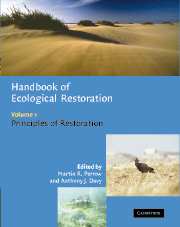Book contents
- Frontmatter
- Contents
- List of contributors
- Foreword
- Preface
- Part 1 The background
- 1 Introduction and philosophy
- 2 Rationale for restoration
- 3 The ecological context: a landscape perspective
- 4 The ecological context: a species population perspective
- 5 The evolutionary context: a species perspective
- Part 2 Manipulation of the physical environment
- Part 3 Manipulation of the chemical environment
- Part 4 Manipulation of the biota
- Part 5 Monitoring and appraisal
- Index
- References
1 - Introduction and philosophy
Published online by Cambridge University Press: 29 December 2009
- Frontmatter
- Contents
- List of contributors
- Foreword
- Preface
- Part 1 The background
- 1 Introduction and philosophy
- 2 Rationale for restoration
- 3 The ecological context: a landscape perspective
- 4 The ecological context: a species population perspective
- 5 The evolutionary context: a species perspective
- Part 2 Manipulation of the physical environment
- Part 3 Manipulation of the chemical environment
- Part 4 Manipulation of the biota
- Part 5 Monitoring and appraisal
- Index
- References
Summary
DEGRADATION AS A UNIVERSAL CONCOMITANT OF HUMAN SOCIETIES
The place of human beings in nature has always been ambivalent. At the present time it is easy to see that we need to cherish nature because, for so many reasons, it supports us. The physiognomy and well-being of our planet depends on its living skin, without which the land would become unstable and, more importantly, its atmosphere would lose its crucial oxygen content, and life as we know it would perish.
Yet at the same time human beings have never been able to live in any sort of stability and comfort without subduing nature to some extent. The early hunter–gatherer activity caused a small amount of damage to existing ecosystems but this was well within the recuperative powers of nature. But, as a result of increasing human populations, inevitably requiring more resources, and the development of techniques of exploitation, such a balanced situation was not to last. The domestication of animals allowed the stocking of selected areas, the domestication of plants allowed them to be grown to order, both permitting higher densities of human populations, with the formation of coherent societies, but with the concomitant destruction of original ecosystems as an incidental necessity.
It is from these considerations that the Judaeo-Christian justification of a domineering approach to nature stems–that man should ‘subdue [the earth]; and have dominion over the fish of the sea, and over the fowl of the air, and over every living thing that moveth upon the earth.’
- Type
- Chapter
- Information
- Handbook of Ecological Restoration , pp. 3 - 9Publisher: Cambridge University PressPrint publication year: 2002
References
- 27
- Cited by



